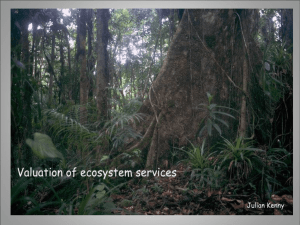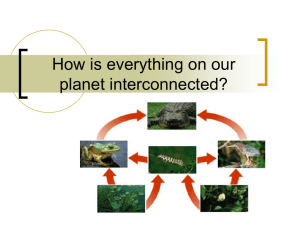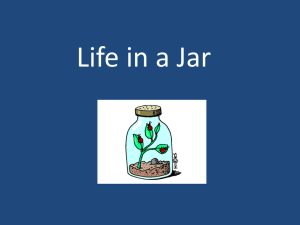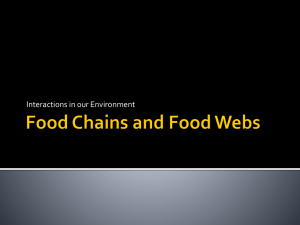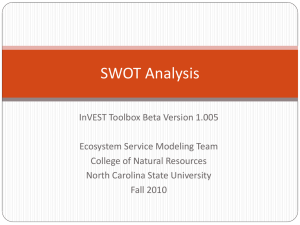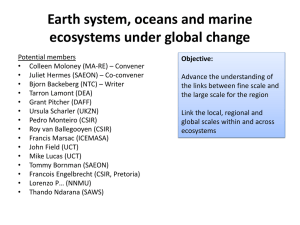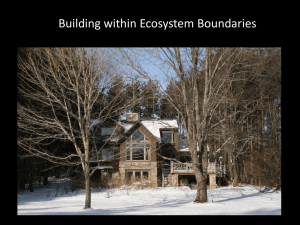Ecological Systems Course Overview - Academy of Geo
advertisement
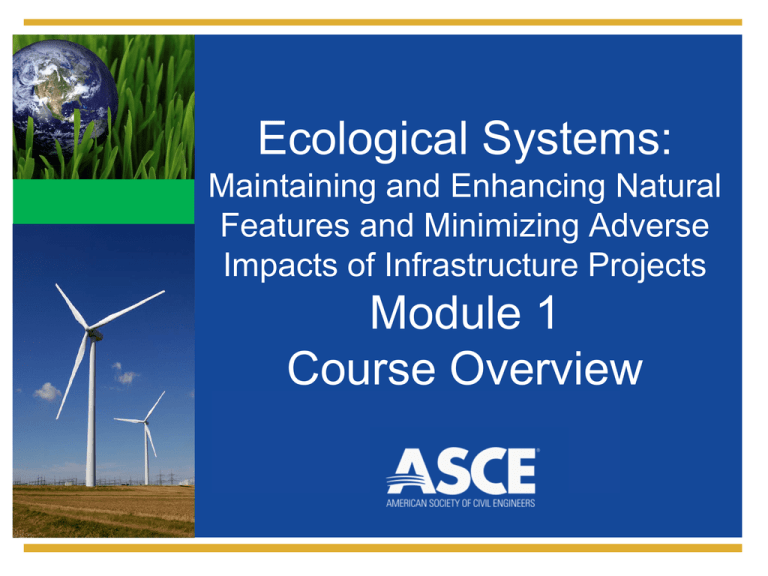
Ecological Systems: Maintaining and Enhancing Natural Features and Minimizing Adverse Impacts of Infrastructure Projects Module 1 Course Overview Emily Mitchell Ayers, Ph.D. The Low Impact Development Center, Inc. emayers@lowimpactdevelopment.org Learning Outcomes • Know the scope and objectives of this Ecological Systems course • Appreciate the need for this course • Know what services are provided by ecosystems • Understand how the course will be structured, and what to expect 1-3 Introduction • Human activities often have adverse environmental impacts • Learning to design infrastructure systems that successfully integrate with the environment requires an understanding of ecology and a knowledgebase of sustainable design techniques 1-4 Outline 1. Ecosystem Services 2. Millennium Ecosystem Assessment 3. Ecologically-Sensitive Design 4. Course Overview 5. Expected Outcomes 1-5 Ecosystem Services Ecosystems provide essential services on which humans depend • • 1-6 • Provisioning services • Regulating services • Supporting services • Cultural services Disturbance of ecosystems can lead to loss or degradation of ecosystem services Provisioning Services Food • Freshwater and marine fisheries • Hunting • Foraging • Managed systems: 1-7 • Crops • Livestock • Aquaculture Lucarelli Provisioning Services Water • Forests generate precipitation • Mountain streams supply snowmelt • Soils recharge groundwater 1-8 NRCS Provisioning Services Timber, Fiber, and Fuel • Forests • Mangroves • Managed systems • Plantations • Crops • Livestock FWS 1-9 Provisioning Services Genetic Diversity Benefits to humanity: • • Disease resistance • Pre-adaptations to emerging threats • Source of new crops 1-10 Breeding Teosinte to Corn John Doebley Provisioning Services Biochemicals and pharmaceuticals “Bioprospecting" is a common source of new medicines 1-11 Generic Function Source Penicillin antibiotic Penicillium fungi Aspirin anti-inflammatory Multiple sources: willow trees, myrtles, meadowsweet Artemisinin antimalarial Sweet wormtree Paclitaxel anticancer Pacific yew (in development) HIV blocker Australian red-eyed tree frog Camptothecin anticancer Camptotheca tree Regulating Services Climate Regulation • • 1-12 Net sink of CO2 • Forests • Wetlands (peat formation) • Oceans Evapotranspiration influences precipitation Victor Grigas Regulating Services Disease and Pest Regulation • Intact ecosystems tend to resist introduction of invasives • Native plants and animals develop resistance to endemic pathogens • When part of a functioning ecosystem, insect populations are controlled, rarely becoming serious pests 1-13 USDA Regulating Services Flood and Natural Hazard Regulation • Wetlands, barrier islands, sand dunes, and coral reefs dissipate wind and storm surges related to hurricanes • Soils absorb rainfall, reducing flooding 1-14 NRCS Regulating Services Water and Air Purification • Wetlands purify water by removing nutrients and degrading organic wastes • Plants absorb air pollutants and provide oxygen NRCS 1-15 Regulating Services Waste Treatment • Microorganisms break down organic wastes • Soils capture and immobilize heavy metals 1-16 NRCS Regulating Services Pollination • 90% of flowering plants depend on animals for pollination • Pollinators are critically important to agricultural production 1-17 FWS Supporting Services • Nutrient cycling • Soil formation • Primary production • Converts sunlight into food for heterotrophs • Produces atmospheric O2 1-18 USDA Cultural Services • Aesthetic • Spiritual • Educational • Recreational 1-19 FWS Millennium Ecosystem Assessment (MA) • Found that 60% of ecosystem services are being degraded or used unsustainably • Fresh water supplies are declining at an unsustainable rate • Degradation of ecosystem functions increases the risk of rapid, nonlinear changes, the results of which can be catastrophic 1-20 Importance to Society • These ecosystem functions are either expensive or impossible to replace with technological solutions • Estimated economic value of all ecosystem services: $33 trillion/year (Costanza et al 1997) 1-21 Mangroves • 35 % have been lost in the last 20 years • Services provided: • Fisheries • Water purification • Nutrient cycling • Carbon sequestration • Storm surge buffering • Causes of decline: • Aquaculture development • Deforestation • Freshwater diversion NOAA 1-22 Coral Reefs • 20% loss in the last few decades • Ecosystem services: • Fisheries • Biodiversity • Storm surge buffering • Causes of decline: • Destructive fishing practices • Pollution • Climate change Public Library of Science 1-23 Tropical Rainforests • Deforestation is responsible for 20% of greenhouse gas emissions • Services provided: • Climate regulation • Nutrient cycling • Genetic diversity • Pharmaceuticals • Disease control • Cause of decline: • Deforestation for agriculture 1-24 © Hans Hillewaert How does infrastructure fit in? Infrastructure shapes the way people relate to the environment • If we build coal-fired power plants, then people cause climate change by turning on their lights • If we build sprawling suburbs, then people are required to drive • Creating highly impervious surfaces degrades streams 1-25 Impacts • Habitat loss • Habitat fragmentation • Pollution • Altered river and estuary hydrology • Climate change • Road kills 1-26 Outline 1. Ecosystem Services 2. Millennium Ecosystem Assessment 3. Ecologically-Sensitive Design 4. Course Overview 5. Expected Outcomes 1-27 Ecologically-sensitive design With an understanding of how infrastructure projects can damage ecosystems, it becomes possible to avoid, prevent, and mitigate these impacts. Infrastructure projects can be designed and implemented in a manner that is ecologically sensitive and sustainable. 1-28 Infrastructure sustainability ASCE definition of sustainability: “A set of environmental, economic and social conditions in which all of society has the capacity and opportunity to maintain and improve its quality of life indefinitely without degrading the quantity, quality or the availability of natural, economic and social resources.” 1-29 Examples of ecologically-sensitive design Low Impact Development • Stormwater runoff is intercepted, cleaned, and infiltrated where appropriate • LID Center 1-30 This approach mitigates many of the harmful impacts of paved surfaces Examples of ecologically-sensitive design Wildlife crossings • Permit migration and movement of animals across roadways • Eliminate habitat fragmentation • Connect ecosystems LID Center 1-31 Examples of ecologically-sensitive design Constructed wetlands DOE 1-32 • Treat wastewater prior to discharge • Remove excess organics and nutrients Discussion Questions How are ecosystem services considered in infrastructure planning? 1-33 Discussion Questions Is it "fair" to ask infrastructure planners to consider impacts on ecosystem services, which may be diffuse, distant, and difficult to quantify? 1-34 Discussion Questions What should the engineer's role be in considering, taking advantage of, and protecting ecosystem services? 1-35 Outline 1. Ecosystem Services 2. Millennium Ecosystem Assessment 3. Ecologically-Sensitive Design 4. Course Overview 5. Expected Outcomes 1-36 Course Objectives • To become familiar with the basic principles of ecology • To learn to anticipate the ecological impacts of infrastructure projects over their entire life cycles from planning to decommissioning • To learn techniques to prevent, minimize, and mitigate these impacts • To learn how to design infrastructure systems that contribute to productive, environmentally restorative and socially desirable uses of land and protection of native flora and fauna. 1-37 Modules of the Course 1. Course Overview: Ecosystem services and the importance of ecologically-sensitive design 2. Introduction to Ecology: Ecological theory 3. Impacts of Infrastructure: What are the major ecological impacts caused by infrastructure, and how do infrastructure projects cause these impacts? 1-38 Modules of the Course 4. Protecting Habitat: Assessing habitat, prioritizing and creating conservation areas 5. Integrating Infrastructure: How to design infrastructure projects that work in harmony with their surroundings 6. Restoring Ecological Function: An overview of the general theory of ecosystem restoration, with examples of restoration in specific contexts 1-39 Introduction to Ecology • What are ecosystems? • What principles govern ecosystem behavior? • How do ecosystems respond to change? 1-40 Impacts of Infrastructure • What ecological impacts are associated with infrastructure? • How do ecosystems become degraded? • What are the local, national, and global implications? 1-41 Protecting Habitat • Site assessment • Identifying critical resources • Conservation design techniques 1-42 Integrating Infrastructure • Anticipating environmental impacts • Strategies and techniques to avoid impacts • Using the Envision™ project rating system 1-43 Restoring Ecological Function • Basic principles of ecological restoration • Examples of restoration techniques • Course wrap-up 1-44 Examination Students will be required to pass a multiple choice examination, which will test understanding of: • • • • • • 1-45 Ecosystem services Principles of ecology How infrastructure can negatively impact ecosystems How to protect habitat How to create ecologically-sensitive designs How to restore ecosystem function Recommended Reading • Millennium Ecosystem Assessment: http://www.millenniumassessment.org • Costanza, R., R. d'Arge, R. de Groot, S. Farberk, M. Grasso, B. Hannon, K. Limburg, S. Naeem, R. V. O'Neill, J. Paruelo, R. G. Raskin, P. Sutton & M. van den Belt, 1997. The value of the world's ecosystem services and natural capital. Nature, vol.387, p.253-260. 1-46
